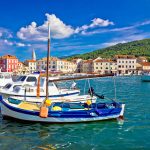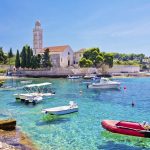If you’re lucky enough to cross the tourist/guest barrier and be invited into a local’s home, you’ll soon become acquainted with the refrain ‘Jedi! Jedi! Jedi!’ (Eat! Eat! Eat!). Sharing food and drink plays a big part in the culture here, which speaks both to the nature of Croatian hospitality and to the quality of local produce. Simple, homestyle cooking is a feature of family-run taverns, but increasingly a new breed of chefs are bringing a more adventurous approach to the table. Meanwhile, Croatian wines and olive oils are making their mark on the world stage, garnering top awards.
Money
The monetary unit in Croatia is the Croatian Kuna (HRK). 1 Kuna = 100 Lipa.
The easiest way to obtain money in Croatia is to draw it out of an ATM (cash machine) on a credit or debit card. ATMs are widely available throughout Croatia and credit cards are accepted in many restaurants and shops. It is also possible to exchange money at hotel reception.
Eating and Drinking
Croatian specialties include Dalmatian or Istrian prosciutto, Pag or Lika cheese, sheep’s cheese, Slavonian paprika flavoured salami (‘kulen’) and Samobor or Zagorje garlic sausages (‘èesnjovka’). There is also a wide selection of meat dishes, including turkey with a special pasta known as ‘mlinci’, roast lamb, roast suckling pig, and boiled or baked ‘strukli’ (pasta with cheese). Croatian vineyards produce reasonable wine – particularly red and you will almost certainly come across plum brandy, a national favourite.
Tipping
In a restaurant, round up the bill unless a service charge has already been added or the service was not up to standard. You should also round up bar bills and taxi fares.
Australia Government Travel Advice
The Australian Government provides up to date information on the safety of travelling to various countries, and all travellers should take note of this advice. Liberty Tours recommends that all travellers take out appropriate Travel Insurance to cover the entire duration of their absence from home. Liberty Tours can assist with obtaining Travel Insurance.
Follow this link for current official assessment:
https://www.smartraveller.gov.au/destinations/europe/croatia
Advice on health risks and vaccination recommendations can also be found using the same link.
Weather
In Croatia, there are three types of climate:
– the climate of Istria, the Adriatic coast and the islands, mild (especially in the southern part) and rainy;
– the climate of the Dinaric Alps, cold and snowy in winter and cool in summer, with thunderstorms in the afternoon;
– the continental climate of the interior plains.
Croatia is moderately rainy in the plains and inland valleys, and definitely rainy along the coast and the western slopes of the mountain ranges. The rainfall pattern is Mediterranean along the coast, with a minimum in summer and a maximum in autumn and winter, while in the interior plains, precipitation is frequent throughout the year, and in winter, it often occurs in the form of snow, but it’s more abundant in summer, when it often occurs in the form of thunderstorms.
For a beach holiday, the best months are July and August. It is worth while to recall that the northernmost part of the coast (Istria, Rijeka) can sometimes experience thunderstorms, or rainy days even in summer, which are rarer along the coast of Dalmatia. In general, autumn rains (which can be heavy in the coastal area) begin in the middle of September. In autumn, the moist southerly winds prevail. You can visit the rest of Croatia (inland regions, including the capital) from May to September. The sun often shines, but during the afternoon, thunderstorms are possible (on average, one day every 3 or 4). In July and August, it can be hot at times, especially in the plains and in inland valleys, so those who don’t like the heat may prefer May, June and September.
What to pack
In winter. In inland areas, bring warm clothes, a hat, a down jacket, a scarf, gloves, and a raincoat or umbrella. On the coast: bring warm clothes, a coat, and a raincoat or umbrella; a hat, a scarf, and gloves for the days with the Bora.
In summer: bring light clothes, T-shirts, but also long pants, a light jacket and a sweatshirt for the evening and for cooler days, especially in inland areas and in Istria; an umbrella or raincoat, especially in inland areas and Istria.







